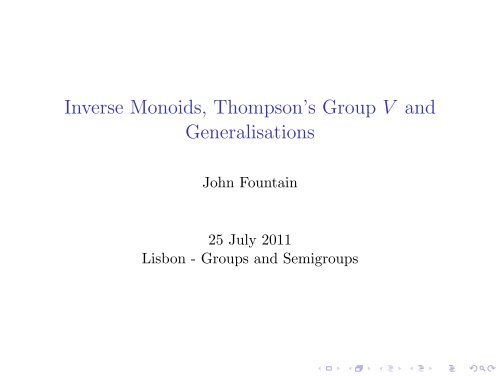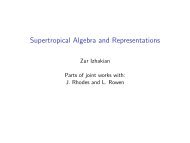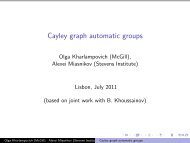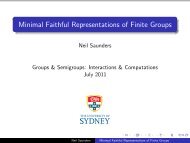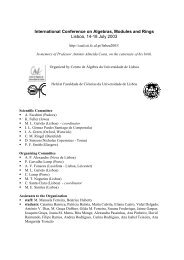Inverse Monoids, Thompson's Group V and Generalisations - CAUL
Inverse Monoids, Thompson's Group V and Generalisations - CAUL
Inverse Monoids, Thompson's Group V and Generalisations - CAUL
You also want an ePaper? Increase the reach of your titles
YUMPU automatically turns print PDFs into web optimized ePapers that Google loves.
<strong>Inverse</strong> <strong>Monoids</strong>, Thompson’s <strong>Group</strong> V <strong>and</strong><br />
<strong>Generalisations</strong><br />
John Fountain<br />
25 July 2011<br />
Lisbon - <strong>Group</strong>s <strong>and</strong> Semigroups
About 1965<br />
F < T < V
Properties<br />
1. V contains every finite group<br />
2. V is simple<br />
3. V is finitely presented<br />
4. V has type F P ∞<br />
5. V has solvable word problem<br />
6. V has solvable conjugacy problem<br />
7. V has a subgroup isomorphic to F 2 × F 2<br />
8. The generalised word problem for V is undecidable
<strong>Inverse</strong> <strong>Monoids</strong><br />
◮ A monoid M is an inverse monoid if<br />
∀a ∈ M, ∃ unique b ∈ M with aba = a <strong>and</strong> bab = b.<br />
b is the inverse of a <strong>and</strong> is denoted by a −1 .
<strong>Inverse</strong> <strong>Monoids</strong><br />
◮ A monoid M is an inverse monoid if<br />
∀a ∈ M, ∃ unique b ∈ M with aba = a <strong>and</strong> bab = b.<br />
b is the inverse of a <strong>and</strong> is denoted by a −1 .<br />
◮ Fact. A monoid M is inverse iff<br />
(i) ∀a ∈ M, ∃ b ∈ M such that aba = a <strong>and</strong><br />
(ii) e 2 = e, f 2 = f ∈ M ⇒ ef = fe.
<strong>Inverse</strong> <strong>Monoids</strong><br />
◮ A monoid M is an inverse monoid if<br />
∀a ∈ M, ∃ unique b ∈ M with aba = a <strong>and</strong> bab = b.<br />
b is the inverse of a <strong>and</strong> is denoted by a −1 .<br />
◮ Fact. A monoid M is inverse iff<br />
(i) ∀a ∈ M, ∃ b ∈ M such that aba = a <strong>and</strong><br />
(ii) e 2 = e, f 2 = f ∈ M ⇒ ef = fe.<br />
◮ Symmetric <strong>Inverse</strong> Monoid<br />
For a set X,<br />
I X<br />
:= set of all bijections between subsets of X.<br />
<strong>Inverse</strong> monoid under composition of partial functions.
<strong>Inverse</strong> <strong>Monoids</strong>: minimum group congruence<br />
◮ M inverse: on M, define σ by<br />
aσb ⇔ ae = be for some e 2 = e.<br />
◮ σ is a congruence <strong>and</strong> M/σ is a group.<br />
◮ If ρ is a congruence on M <strong>and</strong> M/ρ is a group, then ρ ⊆ σ.<br />
◮ Thus σ is the minimum group congruence on M <strong>and</strong> M/σ<br />
is the maximum group homomorphic image of M.
LCM monoids<br />
C is a right LCM monoid if C is left cancellative <strong>and</strong> for<br />
a, b ∈ C, aC ∩ bC = ∅ or is principal.<br />
Artin monoids (in particular, free monoids).
LCM monoids<br />
C is a right LCM monoid if C is left cancellative <strong>and</strong> for<br />
a, b ∈ C, aC ∩ bC = ∅ or is principal.<br />
Artin monoids (in particular, free monoids).<br />
A projective right ideal of C is a disjoint union of principal<br />
right ideals. If<br />
P = a 1 C ⊔ · · · ⊔ a t C<br />
is a projective right ideal, say {a 1 , . . . , a t } is a basis for P .
LCM monoids<br />
C is a right LCM monoid if C is left cancellative <strong>and</strong> for<br />
a, b ∈ C, aC ∩ bC = ∅ or is principal.<br />
Artin monoids (in particular, free monoids).<br />
A projective right ideal of C is a disjoint union of principal<br />
right ideals. If<br />
P = a 1 C ⊔ · · · ⊔ a t C<br />
is a projective right ideal, say {a 1 , . . . , a t } is a basis for P .<br />
A right ideal R of C is essential if R ∩ I ≠ ∅ for every right ideal<br />
I of A ∗ .<br />
Assumption C has finitely generated essential projective right<br />
ideals. Holds if C is a finitely generated monoid.
LCM monoids<br />
C is a right LCM monoid if C is left cancellative <strong>and</strong> for<br />
a, b ∈ C, aC ∩ bC = ∅ or is principal.<br />
Artin monoids (in particular, free monoids).<br />
A projective right ideal of C is a disjoint union of principal<br />
right ideals. If<br />
P = a 1 C ⊔ · · · ⊔ a t C<br />
is a projective right ideal, say {a 1 , . . . , a t } is a basis for P .<br />
A right ideal R of C is essential if R ∩ I ≠ ∅ for every right ideal<br />
I of A ∗ .<br />
Assumption C has finitely generated essential projective right<br />
ideals. Holds if C is a finitely generated monoid.<br />
R e fp<br />
(C):= set of all C-isomorphisms between finitely generated<br />
essential projective right ideals of C. <strong>Inverse</strong> submonoid of I C<br />
.
C = A ∗<br />
◮ A = {a 1 , . . . , a k<br />
}. Every right ideal of A ∗ is projective.
C = A ∗<br />
◮ A = {a 1 , . . . , a k<br />
}. Every right ideal of A ∗ is projective.<br />
◮ A basis for a right ideal of A ∗ is a prefix code P over A:<br />
P ⊆ A ∗ <strong>and</strong> uA ∗ ∩ vA ∗ = ∅ ∀u, v ∈ P .
C = A ∗<br />
◮ A = {a 1 , . . . , a k<br />
}. Every right ideal of A ∗ is projective.<br />
◮ A basis for a right ideal of A ∗ is a prefix code P over A:<br />
P ⊆ A ∗ <strong>and</strong> uA ∗ ∩ vA ∗ = ∅ ∀u, v ∈ P .<br />
◮ P is maximal if for a prefix code Q over A,<br />
P ⊆ Q ⇒ P = Q.
C = A ∗<br />
◮ A = {a 1 , . . . , a k<br />
}. Every right ideal of A ∗ is projective.<br />
◮ A basis for a right ideal of A ∗ is a prefix code P over A:<br />
P ⊆ A ∗ <strong>and</strong> uA ∗ ∩ vA ∗ = ∅ ∀u, v ∈ P .<br />
◮ P is maximal if for a prefix code Q over A,<br />
P ⊆ Q ⇒ P = Q.<br />
◮ If R a right ideal of A ∗ , then<br />
(i) R = P A ∗ for a uniquely determined prefix code P ;<br />
(ii) P is the unique minimal set of generators for R;<br />
(iii) R is essential if <strong>and</strong> only if P maximal.
C = A ∗<br />
◮ A = {a 1 , . . . , a k<br />
}. Every right ideal of A ∗ is projective.<br />
◮ A basis for a right ideal of A ∗ is a prefix code P over A:<br />
P ⊆ A ∗ <strong>and</strong> uA ∗ ∩ vA ∗ = ∅ ∀u, v ∈ P .<br />
◮ P is maximal if for a prefix code Q over A,<br />
P ⊆ Q ⇒ P = Q.<br />
◮ If R a right ideal of A ∗ , then<br />
(i) R = P A ∗ for a uniquely determined prefix code P ;<br />
(ii) P is the unique minimal set of generators for R;<br />
(iii) R is essential if <strong>and</strong> only if P maximal.<br />
◮ V k,1 = V k := R e fp (A∗ )/σ. V = V 2 .
Left Rees <strong>Monoids</strong><br />
Left Rees monoid M: left cancellative; all right ideals projective;<br />
∀a ∈ M, {bM : aM ⊆ bM} is finite.<br />
G, C monoids.Actions: G on C: (g, c) ↦→ g · c; C on G: (g, c) ↦→ g| c .<br />
On C × G define<br />
(c, g)(d, h) = (c(g · d), g| d h).<br />
With appropriate conditions on the actions, get a monoid<br />
C ⊲⊳ G, the Zappa-Szép product of C <strong>and</strong> G.
Left Rees <strong>Monoids</strong><br />
Left Rees monoid M: left cancellative; all right ideals projective;<br />
∀a ∈ M, {bM : aM ⊆ bM} is finite.<br />
G, C monoids.Actions: G on C: (g, c) ↦→ g · c; C on G: (g, c) ↦→ g| c .<br />
On C × G define<br />
(c, g)(d, h) = (c(g · d), g| d h).<br />
With appropriate conditions on the actions, get a monoid<br />
C ⊲⊳ G, the Zappa-Szép product of C <strong>and</strong> G.<br />
Theorem (Lawson).<br />
M is a left Rees monoid iff ∃ set A, group G with M ∼ = A ∗ ⊲⊳ G.<br />
Action of G on A ∗ is self-similar, i.e.,<br />
∀g ∈ G, a ∈ A, ∃ unique b ∈ A, h ∈ G such that<br />
g · (aw) = b(h · w) for all w ∈ A ∗ . (b = g · a <strong>and</strong> h = g| a .)<br />
For A = {a 1 , . . . , a k }, R e fp (A∗ ⊲⊳ G)/σ ∼ = V k (G). (Scott, Röver,<br />
Nekrashevych)
Alternative view of R e fp (C)<br />
Three stage construction from C.<br />
Step 1: C left cancellative, a ∈ C. Define λ a : C → C by<br />
λ a (c) = ac.<br />
is one-one with domain C. IH(C) = Inv〈λ a : a ∈ C〉 ⊆ I C is<br />
the inverse hull of C.<br />
{<br />
IH 0 IH(C) if 0 ∈ IH(C)<br />
(C) =<br />
IH(C) ∪ {0} otherwise.
Alternative view of R e fp (C)<br />
Three stage construction from C.<br />
Step 1: C left cancellative, a ∈ C. Define λ a : C → C by<br />
λ a (c) = ac.<br />
is one-one with domain C. IH(C) = Inv〈λ a : a ∈ C〉 ⊆ I C is<br />
the inverse hull of C.<br />
{<br />
IH 0 IH(C) if 0 ∈ IH(C)<br />
(C) =<br />
IH(C) ∪ {0} otherwise.<br />
C is a right LCM monoid iff every non-zero element of IH 0 (C)<br />
can be written as λ a λ −1<br />
b<br />
for some a, b ∈ C.<br />
Part of a theorem due to McAlister <strong>and</strong> independently<br />
Nivat/Perrot.
Alternative view of Rfp e (C): Step 2<br />
S inverse monoid with zero. a, b ∈ S are orthogonal (a ⊥ b) if<br />
a −1 b = 0 = ab −1 .<br />
Clearly, a ⊥ b iff aa −1 ⊥ bb −1 <strong>and</strong> a −1 a ⊥ b −1 b.<br />
A ⊆ S is orthogonal if a ⊥ b for all distinct a, b ∈ A.
Alternative view of Rfp e (C): Step 2<br />
S inverse monoid with zero. a, b ∈ S are orthogonal (a ⊥ b) if<br />
a −1 b = 0 = ab −1 .<br />
Clearly, a ⊥ b iff aa −1 ⊥ bb −1 <strong>and</strong> a −1 a ⊥ b −1 b.<br />
A ⊆ S is orthogonal if a ⊥ b for all distinct a, b ∈ A.<br />
Define<br />
D(S) = {A ⊆ S : 0 ∈ A, |A| < ∞, A is orthogonal}.<br />
Then D(S) is an inverse submonoid of P (S) <strong>and</strong> the map given<br />
by a ↦→ {0, a} embeds S in D(S).<br />
Theorem<br />
If C is a right LCM monoid, then D(IH 0 (C)) ∼ = R fp (C) where<br />
R fp (C) is the inverse monoid of all C-isomorphisms between<br />
finitely generated projective right ideals of C.
Alternative view of Rfp e (C): Step 3<br />
S inverse monoid with zero.<br />
S e := {a ∈ S : Sa <strong>and</strong> aS are essential}.<br />
S e is an inverse submonoid of S called the essential part of S.<br />
An idempotent e is essential if e ∈ S e . This is true if <strong>and</strong> only if<br />
ef ≠ 0 for all non-zero idempotents f of S.<br />
a ∈ S e if <strong>and</strong> only if aa −1 <strong>and</strong> a −1 a are essential idempotents
Alternative view of Rfp e (C): Step 3<br />
S inverse monoid with zero.<br />
S e := {a ∈ S : Sa <strong>and</strong> aS are essential}.<br />
S e is an inverse submonoid of S called the essential part of S.<br />
An idempotent e is essential if e ∈ S e . This is true if <strong>and</strong> only if<br />
ef ≠ 0 for all non-zero idempotents f of S.<br />
a ∈ S e if <strong>and</strong> only if aa −1 <strong>and</strong> a −1 a are essential idempotents<br />
The isomorphism D(IH 0 (C)) ∼ = R fp (C) restricts to an<br />
isomorphism<br />
D e (IH 0 (C)) ∼ = R e fp (C).
Right Ore Right LCM <strong>Monoids</strong><br />
Let C be right Ore <strong>and</strong> right LCM. Then every projective right<br />
ideal is principal. (Two principal right ideals cannot be<br />
disjoint).<br />
So, all orthogonal subsets of IH 0 (C) have the form {λ a λ −1<br />
b<br />
, 0};<br />
hence the embedding of IH 0 (C) into D(IH 0 (C)) is surjective.<br />
Every nonzero idempotent of IH 0 (C) is essential. So<br />
D e (IH 0 (C)) = IH(C).<br />
For cancellative right Ore C it is well known that the group<br />
G(C) of right fractions of C is isomorphic to IH(C)/σ, so in<br />
this case, R e fp (C) ∼ = G(C).
More on Zappa-Szép Products I<br />
Let C be a right LCM monoid with trivial group of units, <strong>and</strong><br />
G be a group. Suppose we have actions so that we can form<br />
D = C ⊲⊳ G. Then<br />
1. D is left cancellative;<br />
2. D is right LCM;<br />
3. the group of units of D is {(1, g) : g ∈ G};<br />
4. the partially ordered set of principal right ideals of D is<br />
order-isomorphic to the partially ordered set of principal<br />
right ideals of C.
More on Zappa-Szép Products II<br />
Remember that for any right LCM monoid B,<br />
λ a λ −1<br />
b<br />
IH 0 (B) = {λ a λ −1<br />
b<br />
: a, b ∈ B} ∪ {0}.<br />
= λ c λ −1<br />
d<br />
⇔ ∃ unit u ∈ B such that au = c, bu = d.<br />
Write elements of IH 0 (B) as ∼-equivalence classes [a, b] where<br />
(a, b) ∼ (c, d) ⇔ ∃ unit u ∈ B such that au = c, bu = d.
More on Zappa-Szép Products II<br />
Remember that for any right LCM monoid B,<br />
λ a λ −1<br />
b<br />
IH 0 (B) = {λ a λ −1<br />
b<br />
: a, b ∈ B} ∪ {0}.<br />
= λ c λ −1<br />
d<br />
⇔ ∃ unit u ∈ B such that au = c, bu = d.<br />
Write elements of IH 0 (B) as ∼-equivalence classes [a, b] where<br />
(a, b) ∼ (c, d) ⇔ ∃ unit u ∈ B such that au = c, bu = d.<br />
Now consider IH 0 (D) where D = C ⊲⊳ G. Elements are:<br />
[(a, g), (b, h)] = [(a, gh −1 ), (b, 1)]<br />
so we can represent elements by triples (a, g, b) ∈ C × G × C.
More on Zappa-Szép Products III: Orthogonal Subsets<br />
The following are equivalent:<br />
1. X = {(a 1 , g 1 , b 1 ), . . . , (a t , g t , b t )} ∪ {0} is an orthogonal<br />
subset of IH 0 (D);<br />
2. X = {λ a1<br />
λ −1<br />
b<br />
, . . . , λ at<br />
λ −1<br />
1 b<br />
} ∪ {0} is an orthogonal subset of<br />
t<br />
IH 0 (C);<br />
3. A = {a 1 , . . . , a t } <strong>and</strong> B = {b 1 , . . . , b t } are bases for<br />
projective right ideals of C.
More on Zappa-Szép Products III: Orthogonal Subsets<br />
The following are equivalent:<br />
1. X = {(a 1 , g 1 , b 1 ), . . . , (a t , g t , b t )} ∪ {0} is an orthogonal<br />
subset of IH 0 (D);<br />
2. X = {λ a1<br />
λ −1<br />
b<br />
, . . . , λ at<br />
λ −1<br />
1 b<br />
} ∪ {0} is an orthogonal subset of<br />
t<br />
IH 0 (C);<br />
3. A = {a 1 , . . . , a t } <strong>and</strong> B = {b 1 , . . . , b t } are bases for<br />
projective right ideals of C.<br />
Consequently,<br />
D e (IH 0 (D)) = {X : X ∈ D e (IH 0 (C))}<br />
= {X : A, B are bases for essential projective right ideals}.
Brin’s groups<br />
Brin studied groups nV described as subgroups of the<br />
homeomorphism group of C × · · · × C (n factors) where C is the<br />
Cantor set.<br />
Also describes groups nV k .
Brin’s groups<br />
Brin studied groups nV described as subgroups of the<br />
homeomorphism group of C × · · · × C (n factors) where C is the<br />
Cantor set.<br />
Also describes groups nV k .<br />
Properties<br />
◮ nV is simple.<br />
◮ nV is finitely presented.<br />
◮ nV contains a copy of every finite group.<br />
◮ 2V <strong>and</strong> 3V are of type F ∞ (so of type F P ∞ ).<br />
(Kochloukova, Martínez-Pérez, Nucinkis)
Brin’s groups<br />
Brin studied groups nV described as subgroups of the<br />
homeomorphism group of C × · · · × C (n factors) where C is the<br />
Cantor set.<br />
Also describes groups nV k .<br />
Properties<br />
◮ nV is simple.<br />
◮ nV is finitely presented.<br />
◮ nV contains a copy of every finite group.<br />
◮ 2V <strong>and</strong> 3V are of type F ∞ (so of type F P ∞ ).<br />
(Kochloukova, Martínez-Pérez, Nucinkis)<br />
If |A| = k <strong>and</strong> C = A ∗ × · · · × A ∗ (n factors), then<br />
R e fp (C)/σ ∼ = nV k .
Higman algebras (1974)<br />
◮ An algebra U with k (k 2) unary operations α 1 , . . . , α k<br />
<strong>and</strong> one k-ary operation λ satisfying<br />
(aα 1 , . . . , aα k )λ = a<br />
for all a, a 1 , . . . , a k<br />
∈ U<br />
(a 1 , . . . , a k )λα i = a i (i = 1, . . . , k)
Higman algebras (1974)<br />
◮ An algebra U with k (k 2) unary operations α 1 , . . . , α k<br />
<strong>and</strong> one k-ary operation λ satisfying<br />
(aα 1 , . . . , aα k )λ = a<br />
for all a, a 1 , . . . , a k<br />
∈ U<br />
(a 1 , . . . , a k )λα i = a i (i = 1, . . . , k)<br />
◮ The free Higman k-algebra F k (x) on {x} has bases of every<br />
finite non-zero cardinality.<br />
◮ k = 2 (Jónsson-Tarski (1961).
Higman algebras (1974)<br />
◮ An algebra U with k (k 2) unary operations α 1 , . . . , α k<br />
<strong>and</strong> one k-ary operation λ satisfying<br />
(aα 1 , . . . , aα k )λ = a<br />
for all a, a 1 , . . . , a k<br />
∈ U<br />
(a 1 , . . . , a k )λα i = a i (i = 1, . . . , k)<br />
◮ The free Higman k-algebra F k (x) on {x} has bases of every<br />
finite non-zero cardinality.<br />
◮ k = 2 (Jónsson-Tarski (1961).<br />
◮ V k<br />
∼ = the automorphism group of Fk (x).
Generalised Higman algebras 2010<br />
Given S = {1, . . . , s} <strong>and</strong> an integer k i > 1 for each i ∈ S,<br />
an algebra U with, for each i ∈ S, k i unary operations<br />
αi 1, . . . , αk i<br />
i<br />
<strong>and</strong> one k i -ary operation λ i satisfying:<br />
(aαi 1 , . . . , aα k i<br />
i )λ i = a<br />
(a 1 , . . . , a ki<br />
)λ i α j i = a j (j = 1, . . . , k i )<br />
for all a, a 1 , . . . , a ki<br />
∈ U <strong>and</strong> i ∈ S.<br />
Also have a set Σ of laws (possibly empty) given by equations<br />
between words in the α j i
Generalised Higman algebras 2010<br />
Given S = {1, . . . , s} <strong>and</strong> an integer k i > 1 for each i ∈ S,<br />
an algebra U with, for each i ∈ S, k i unary operations<br />
αi 1, . . . , αk i<br />
i<br />
<strong>and</strong> one k i -ary operation λ i satisfying:<br />
(aαi 1 , . . . , aα k i<br />
i )λ i = a<br />
(a 1 , . . . , a ki<br />
)λ i α j i = a j (j = 1, . . . , k i )<br />
for all a, a 1 , . . . , a ki<br />
∈ U <strong>and</strong> i ∈ S.<br />
Also have a set Σ of laws (possibly empty) given by equations<br />
between words in the α j i<br />
Kochloukova, Martínez-Pérez <strong>and</strong> Nucinkis use free generalised<br />
Higman algebras to get their results on 2V <strong>and</strong> 3V .
Generalised Higman algebras 2010<br />
Given S = {1, . . . , s} <strong>and</strong> an integer k i > 1 for each i ∈ S,<br />
an algebra U with, for each i ∈ S, k i unary operations<br />
αi 1, . . . , αk i<br />
i<br />
<strong>and</strong> one k i -ary operation λ i satisfying:<br />
(aαi 1 , . . . , aα k i<br />
i )λ i = a<br />
(a 1 , . . . , a ki<br />
)λ i α j i = a j (j = 1, . . . , k i )<br />
for all a, a 1 , . . . , a ki<br />
∈ U <strong>and</strong> i ∈ S.<br />
Also have a set Σ of laws (possibly empty) given by equations<br />
between words in the α j i<br />
Kochloukova, Martínez-Pérez <strong>and</strong> Nucinkis use free generalised<br />
Higman algebras to get their results on 2V <strong>and</strong> 3V .<br />
Associated monoid presentation 〈{α j i : 1 i s; 1 j k i}|Σ〉.<br />
In particular, the set of laws for the generalised Higman algebra<br />
with automorphism group nV gives the presentation for<br />
A ∗ × · · · × A ∗ (n factors) with |A| = 2.
Brown-Stein groups<br />
Let P ⊆ R >0 be a finitely generated multiplicative group.<br />
Let A be a ZP -submodule of R with P A = A.<br />
Let l ∈ A, l > 0.<br />
G(l, A, P ) is the group of right continuous bijections of [0, l)<br />
that are piecewise linear with a finite number of discontinuities<br />
<strong>and</strong> singularities, all in A, slopes in P , <strong>and</strong> mapping A ∩ [0, l)<br />
to itself.<br />
Theorem (Stein)<br />
G(1, Z[ 1 k ], 〈k〉) ∼ = V k<br />
The commutator subgroup of G(l, A, P ) is simple.
Brown-Stein groups II<br />
Stein shows that we can take P to have a basis (as a free<br />
abelian group) {k 1 , . . . , k s } with the k i being positive integers<br />
<strong>and</strong> A = Z[ 1 k 1<br />
, . . . , 1 k s<br />
].<br />
For G = G(l, A, P ) with the above P <strong>and</strong> A, Martínez-Pérez<br />
<strong>and</strong> Nucinkis give a set of laws for a generalised Higman algebra<br />
with automorphism group isomorphic to G. Here we have<br />
S = {1, . . . , s} <strong>and</strong> associated integers k i , i = 1, . . . , s. The laws<br />
are:<br />
(α 1 i α1 j , . . . , α1 i αk j<br />
j , α2 i α1 j , . . . , α2 i αk j<br />
j , . . . , αk i<br />
i α1 j , . . . , αk i<br />
i αk j<br />
j ) =<br />
(α 1 j α1 i , . . . , α1 j αk i<br />
i , α2 j α1 i , . . . , α2 j αk i<br />
i , . . . , αk j<br />
j α1 i , . . . , αk j<br />
j αk i<br />
i )<br />
where i ≠ j <strong>and</strong> i, j ∈ {1, . . . , s}.


